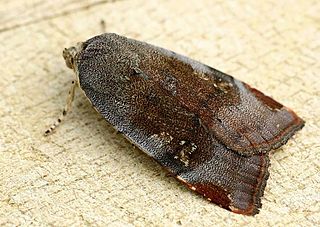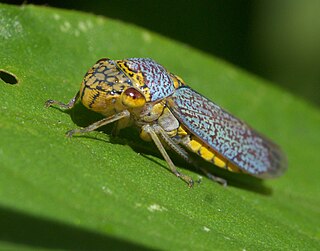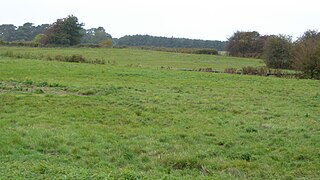In Roman mythology, Orbona was the goddess who granted new children to parents who had become childless. She was also the goddess of children, especially orphans.

Noctua is a genus of moths. They have dull, cryptic forewings and often very bright hindwings. These are hidden under the forewings when the moths rest, leading to their common name of yellow underwings. They are not particularly closely related to the "true" underwing moths (Catocala) though, apart from both being Noctuoidea. They are good fliers.
Xanthomonas fragariae is a species of bacteria. It causes a leaf spot disease found in strawberries. The type strain is NCPPB1469 from Fragaria chiloensis var. ananassa.

Ceratobasidium cornigerum is a species of fungus in the order Cantharellales. Basidiocarps are thin, spread on the substrate out like a film (effused) and web-like. An anamorphic state is frequently obtained when isolates are cultured. Ceratobasidium cornigerum is saprotrophic, but is also a facultative plant pathogen, causing a number of economically important crop diseases, and an orchid endomycorrhizal associate. The species is genetically diverse and is sometimes treated as a complex of closely related taxa. DNA research shows the species actually belongs within the genus Rhizoctonia.
Phytophthora fragariae is a fungus-like (oomycete) plant pathogen that causes red stele, otherwise known as Lanarkshire disease, in strawberries. Symptoms of red stele can include a red core in the roots, wilting of leaves, reduced flowering, stunting, and bitter fruit. The pathogen is spread via zoospores swimming through water present in the soil, released from sporangia.
Coniella fragariae is a plant pathogen. It is known to be pathogenic on eucalypts in a number of countries, including Brazil, India, China and Australia. In 2015, Coniella fragariae was reported as the causal agent for strawberry crown rot in Latvia. In 2018, the fungus was isolated from a goose dung collected in a strawberry field near the sea coast in North Germany. Inferred from the author, it should be a typical plant pathogenic fungus not coprophilous fungus. The plants, strawberry that had been eaten by geese are expected to be the true source of Coniella fragariae. Chemical constitution study showed azaphilone were the main secondary metabolites from this fungus.
Colletotrichum fragariae is a fungal plant pathogen infecting strawberries. It is not a well known fungus, and there are many similar fungi that are related to it. It is part of the Colletotrichum genus. It is a pathogen that occurs in strawberries. It leads to the disease known as anthracnose. This is typically at the crown of the strawberry, which is why it is often called crown rot. It is also known as the Anthracnose Crown rot. The fungus also infects leaves and is known as leaf spot, which is common among all Colletotrichum. This is not as common in the fragariae, as it is more common in the crown. This fungus is also better at infecting younger strawberries/seedlings. The most common way to control this disease is fungicides that are harmful to the environment. There have been studies done to see if the fungus infects other hosts but other than some weeds, it is very specific to Strawberries.
Strawberry foliar nematode, or strawberry crimp nematode, is a disease caused by Aphelenchoides fragariae, a plant pathogenic nematode. It is common in strawberries and ornamental plants and can greatly affect plant yield and appearance, resulting in a loss of millions of dollars of revenue. Symptoms used to diagnose the disease are angular, water soaked lesions and necrotic blotches. Aphelenchoides fragariae is the nematode pathogen that causes the disease. Its biological cycle includes four life stages, three of which are juvenile. The nematode can undergo multiple life cycles in one growing season when favorable conditions are present. The crowns, runners, foliage, and new buds of the plant via stylet penetration or through the stomata can be infected. The best management practices for this disease are sanitation, prevention of induction of the pathogen to the environment, and planting clean seed or starter plants.
Orbona is a genus of moths of the family Noctuidae.

Oncometopia is a genus of sharpshooters found in North and South America. The genus was erected by Carl Stål in 1869.
Asota orbona is a moth of the family Erebidae first described by Samuel Constantinus Snellen van Vollenhoven in 1863. It is found in Indonesia, Papua New Guinea and Queensland.

Ancylis comptana, the strawberry leaf-roller or Comptan's ancylis moth, is a moth of the family Tortricidae. It is found from the United Kingdom and Scandinavia to northern Spain and Turkey, Asia Minor, Kazakhstan, Uzbekistan, Russia, China, Mongolia, Korea and Japan. In North America, it is represented by ssp. fragariae.

Appias epaphia, the diverse white or African albatross, is a butterfly of the family Pieridae. It is found in Africa, south of the Sahara. The habitat consists of forests and heavy woodland.
Paraamblyseius is a genus of mites in the Phytoseiidae family.

The Search for WondLa is a children's science fiction fantasy novel by Tony DiTerlizzi published in 2010. It is the first book of the WondLa series. The website dedicated to the book had an innovative section which interacts with the book's illustrations via webcam.

Dixeia orbona, the creamy small white, is a butterfly in the family Pieridae. It is found in Senegal, the Gambia, Guinea-Bissau, Burkina Faso, Ghana, Nigeria, Cameroon, Sudan, Ethiopia, the Democratic Republic of the Congo, Uganda, Kenya and Tanzania. The habitat consists of open woodland and open montane forests, particularly forest-grassland mosaic.
Ormetica orbona is a moth of the family Erebidae. It was described by William Schaus in 1889. It is found in Mexico.

Oncometopia orbona, the broad-headed sharpshooter, is a species of sharpshooter in the family Cicadellidae.
Tyloderma fragariae, the strawberry crown borer, is a species of hidden snout weevil in the beetle family Curculionidae.

Old Bodney Camp is a 32.8-hectare (81-acre) biological Site of Special Scientific Interest west of Little Cressingham in Norfolk. It is part of the Breckland Special Protection Area.









